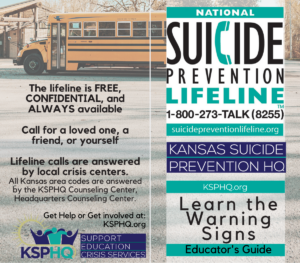
Learn the Warning Signs of Suicide
Immediate Warning Signs:
- Talking or writing about suicide
- Has a plan
- Expressing hopelessness about the future
- Making preparations for suicide (giving away belongings, writing a suicide note, looking for means to attempt suicide)
Other Warning Signs:
- Unusual fatigue/more energy
- Lack of concentration
- Changes in hygiene
- Increasing use of alcohol, drugs or other risky behavior
- Increasingly agitated, anxious, sad, angry
- Withdrawing from social activities
- Spending more time alone, isolating
- Experience of loss
- Academic problems
If you’re concerned that a student might be considering suicide:
- Ask directly – “are you thinking about suicide?”
- Stop what you are doing and take immediate action
- Listen – threats about suicide must be taken seriously
- Be non-judgmental and offer empathy
- Don’t leave them alone
- Contact the building administrator or designee
Things you can say:
- “I care and will help.”
- Reflect what they share to let them know they have been heard
- “Thank you so much for telling me.”
- “I want to work together to get you help.”

School-based training and presentations
Sources of Strength
A best practice youth suicide prevention project designed to harness the power of peer social networks to change unhealthy norms and culture, ultimately preventing suicide, bullying, and substance abuse. The mission of Sources of Strength is to prevent suicide by increasing help-seeking behaviors and promoting connections between peers and caring adults. Sources of Strength moves beyond a singular focus on risk factors by utilizing an upstream approach for youth suicide prevention. This upstream model strengthens multiple sources of support (protective factors) around young individuals so that when times get hard they have strengths to rely on.
Suicide in Schools
Suicide in Schools is a comprehensive guide for school-based suicide prevention and postvention. Presentations are customized to the needs of the participating school. The length of the presentation is determined by learning objectives.
Talking Together and Suicide Prevention
Talking Together and Suicide Prevention is an evidence-based program that is implemented in grade school classrooms. The curriculum is presented by teachers and focuses on creating safe learning environments, building social and problem-solving skills in students. The KSPRC training focuses on helping teachers learn to deliver the program.
You are a Lifesaver
A 90 to 120-minute presentation for school staff and teachers drawn from Suicide in Schools: A Practitioner’s Guide to Multi-Level Prevention, Assessment, Intervention, and Postvention. This presentation is suitable for meeting the Jason Flatt Act training requirements. It can also be adapted for students and parents.
More Than Sad
A high-school program consisting of two, 45-minute presentations in the classroom. The program includes videos that are shown in class, followed by a teacher-led discussion with the students about depression awareness and suicide prevention. This is an AFSP product in which KSPRC staff is available to provide the Train the Trainer for implementation in classrooms.
Contact us or sign up for the newsletter to find a training near you.
Resources for Educators
- Kansas Prevention Collaborative
- Kansas Communities That Care
- Find your local Community Mental Health Care Center
- The National Suicide Prevention Lifeline: 1-800-273-8255
- Crisis Text Line: text KANSAS to 741-741
- How the Lifeline works
